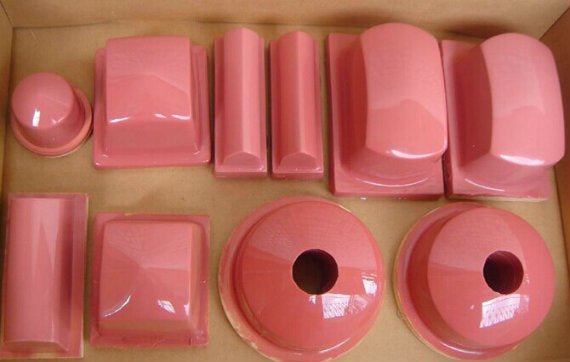on eligible orders over $150
on eligible orders over $150

When selecting a pad for pad printing, you need to consider shape, size, and hardness. If you have trouble finding the right pad, All American has a variety of pads in stock and carries molds for more than 1,000 different pads. Please be aware it takes 5 – 7 days to produce custom pads. For questions and orders please call (215)-634-2235 Mon.-Fri. from 9:00 a.m. to 5:30 p.m. (EST). If you'd like to know more about our pads visit Request a Custom Pad.
Pads come in 3 basic shapes: round, rectangular, and bar. Generally, the pad with the steepest angle, hardest durometer, and the greatest mass will create the best print. Look for a pad shape that covers the entire profile of your desired image. During testing, make sure your pad is leaving an even ink deposit with no pinholes or distortion. Remember, a pad should never form a 0° angle with the surface, air will get trapped underneath the pad. Also, avoid using the pad’s apex for an ink deposit because it will thin the ink.
The pad needs to be at least 20-30% larger than the image size. A larger pad usually means less image distortion. It's a good idea to use the largest practical pad for printing. The distance between the machine’s body and the cliché will limit the maximum pad size you can use. Also, if you’re using a low-power machine or manual machine, you might have to use a smaller, softer pad.
The amount of silicone oil used in the molding process changes a pad’s hardness. The hardness of a pad is measured by a shore durometer scale. A hard pad provides the crispest image and works best on textured and raised surfaces. Soft pads are recommended for heavily contoured surfaces or fragile items. If you are using a low-power machine that can’t compress a hard pad fully, a softer pad should be used instead. Also, do not use pads that are not the same hardness when printing, especially if you are using a pad "nest" or matrix. Using different durometers simultaneously will cause uneven ink distribution. All American offers pads in durometers of 30 to 65 or more depending on the application.
Before use, clean the surface of the pad with alcohol. This removes any excess silicone oil and helps break in the pad. After the first wipe down, use plastic box sealing tape to remove dirt from the pad’s surface. If the pad is cleaned with solvent too often, the silicone oils can be depleted and shorten the life of your pad. If the ink won’t easily release from the pad's surface, it might have been damaged by excessive solvent cleaning.
Leave a comment